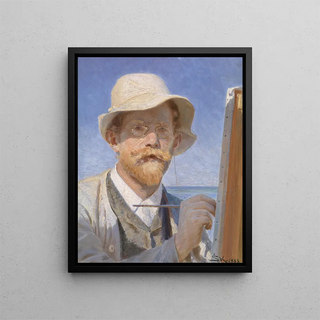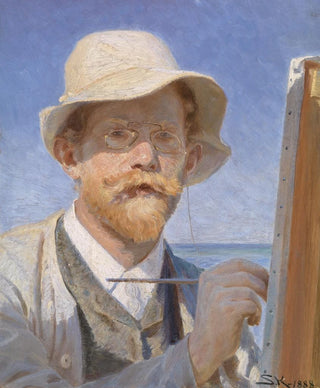Art print | Self-portrait - Peder Severin Krøyer


View from behind

Frame (optional)
Peder Severin Krøyer's art print of his self-portrait is a work that transcends the simple act of self-representation. It embodies not only the artistic vision of a man but also the essence of an era marked by the realism movement and the emergence of modernism. This painting, where the artist reveals himself with an almost palpable intensity, invites us to delve into the universe of art at the end of the 19th century—a period when artists sought to capture not only reality but also their emotions and identity. Through this work, Krøyer offers us a window into his soul, while also prompting broader reflection on art and the human condition.
Style and uniqueness of the work
The art print of Krøyer's self-portrait stands out for its unique style, characterized by a subtle play of light and shadow. The artist uses delicate colors and brush techniques that seem to almost vibrate on the canvas. The composition, both dynamic and harmonious, draws the eye toward the painter's face, where every detail is carefully crafted. The eyes, in particular, are of a disturbing depth, evoking a multitude of thoughts and emotions. This piece does not merely depict an individual; it captures the very essence of creativity and artistic reflection. By painting himself in an intimate setting, Krøyer manages to establish a dialogue between himself and the viewer, making the work even more engaging.
The artist and his influence
Peder Severin Krøyer is an emblematic figure of the Skagen movement, a group of Danish artists inspired by the landscapes and light of Northern Europe. His work is marked by an relentless quest for truth and beauty—themes that resonate deeply in his art print of his self-portrait. Krøyer, through his innovative approach to color and light, influenced many contemporary and future artists, redefining portrait painting standards. His ability to capture fleeting moments with striking precision paved the way for a new understanding of art, where the artist's individuality plays a central role. Exploring human emotions and

Matte finish

View from behind

Frame (optional)
Peder Severin Krøyer's art print of his self-portrait is a work that transcends the simple act of self-representation. It embodies not only the artistic vision of a man but also the essence of an era marked by the realism movement and the emergence of modernism. This painting, where the artist reveals himself with an almost palpable intensity, invites us to delve into the universe of art at the end of the 19th century—a period when artists sought to capture not only reality but also their emotions and identity. Through this work, Krøyer offers us a window into his soul, while also prompting broader reflection on art and the human condition.
Style and uniqueness of the work
The art print of Krøyer's self-portrait stands out for its unique style, characterized by a subtle play of light and shadow. The artist uses delicate colors and brush techniques that seem to almost vibrate on the canvas. The composition, both dynamic and harmonious, draws the eye toward the painter's face, where every detail is carefully crafted. The eyes, in particular, are of a disturbing depth, evoking a multitude of thoughts and emotions. This piece does not merely depict an individual; it captures the very essence of creativity and artistic reflection. By painting himself in an intimate setting, Krøyer manages to establish a dialogue between himself and the viewer, making the work even more engaging.
The artist and his influence
Peder Severin Krøyer is an emblematic figure of the Skagen movement, a group of Danish artists inspired by the landscapes and light of Northern Europe. His work is marked by an relentless quest for truth and beauty—themes that resonate deeply in his art print of his self-portrait. Krøyer, through his innovative approach to color and light, influenced many contemporary and future artists, redefining portrait painting standards. His ability to capture fleeting moments with striking precision paved the way for a new understanding of art, where the artist's individuality plays a central role. Exploring human emotions and






